Marketing Environmental Analysis Report: Donald B's Business Strategy
VerifiedAdded on 2021/04/17
|18
|4862
|38
Report
AI Summary
This report provides a comprehensive marketing environmental analysis for Donald B, a Melbourne-based chocolate company. The analysis covers both macro-environmental factors, including political, economic, social, technological, environmental, and legal aspects impacting the Australian chocolate market, and micro-environmental factors such as supplier and customer bargaining power, the threat of new entrants and substitutes, and competitive rivalry. The report also examines consumer behavior, market trends, and the competitive landscape, considering both direct and indirect competitors. The study aims to inform Donald B's expansion strategy by identifying potential opportunities and challenges within the Australian chocolate industry and globally. The report considers the increasing demand for milk-based chocolates, the impact of foreign brands, and the importance of corporate social responsibility in the context of cocoa production and child labor issues. The report concludes by highlighting the need for strategic capabilities to compete effectively in the mass market and the importance of understanding consumer preferences and behaviors.
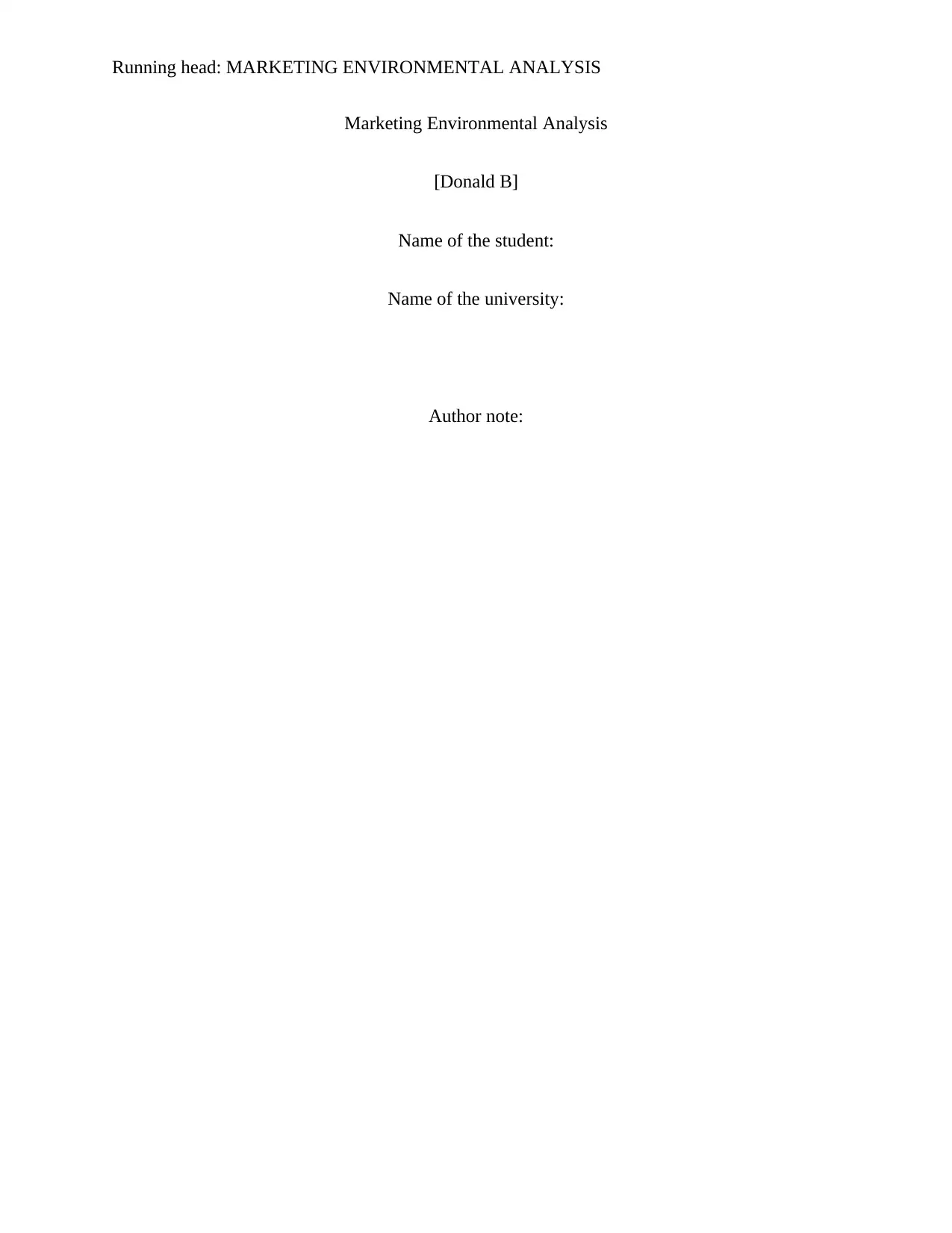
Running head: MARKETING ENVIRONMENTAL ANALYSIS
Marketing Environmental Analysis
[Donald B]
Name of the student:
Name of the university:
Author note:
Marketing Environmental Analysis
[Donald B]
Name of the student:
Name of the university:
Author note:
Paraphrase This Document
Need a fresh take? Get an instant paraphrase of this document with our AI Paraphraser
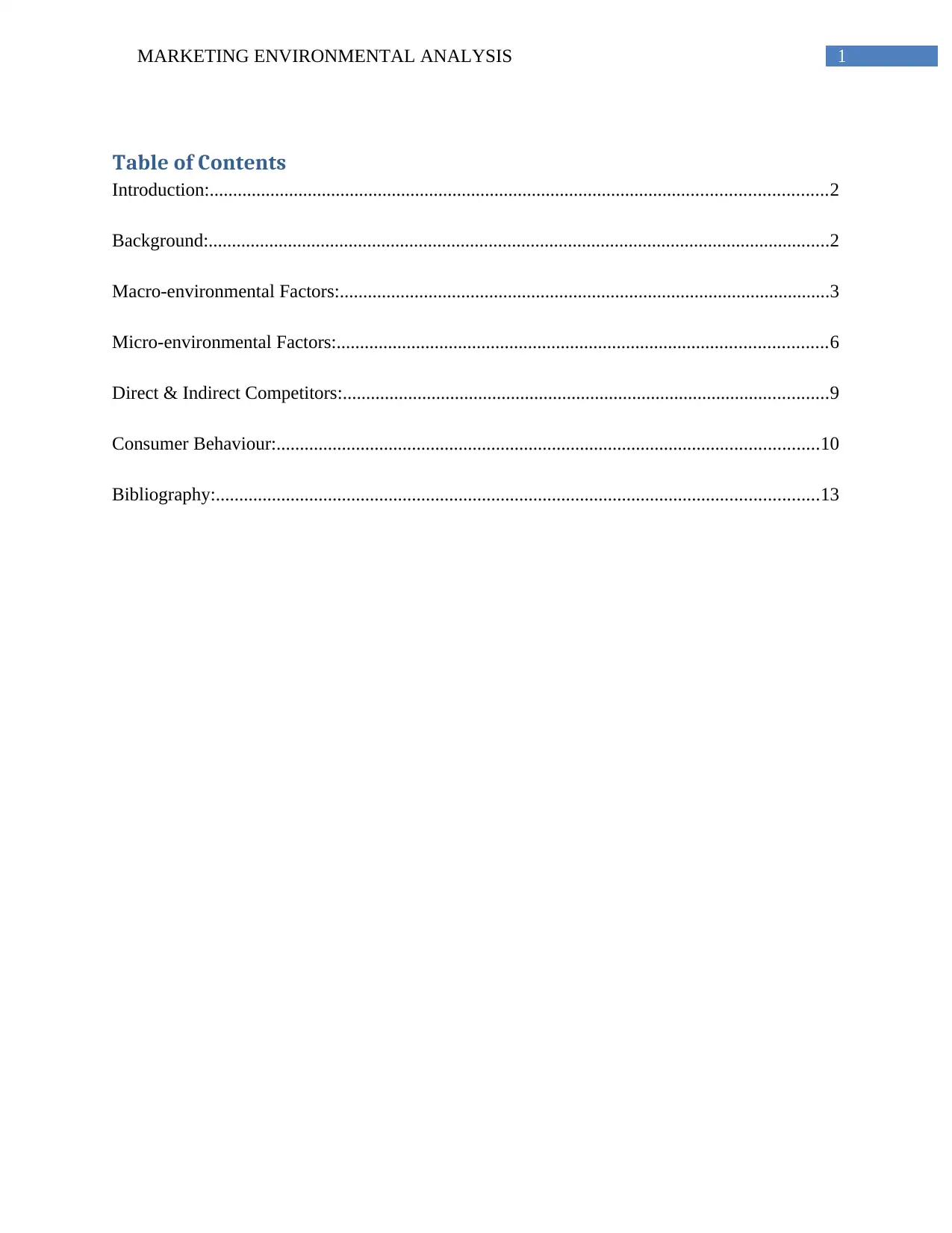
1MARKETING ENVIRONMENTAL ANALYSIS
Table of Contents
Introduction:....................................................................................................................................2
Background:.....................................................................................................................................2
Macro-environmental Factors:.........................................................................................................3
Micro-environmental Factors:.........................................................................................................6
Direct & Indirect Competitors:........................................................................................................9
Consumer Behaviour:....................................................................................................................10
Bibliography:.................................................................................................................................13
Table of Contents
Introduction:....................................................................................................................................2
Background:.....................................................................................................................................2
Macro-environmental Factors:.........................................................................................................3
Micro-environmental Factors:.........................................................................................................6
Direct & Indirect Competitors:........................................................................................................9
Consumer Behaviour:....................................................................................................................10
Bibliography:.................................................................................................................................13
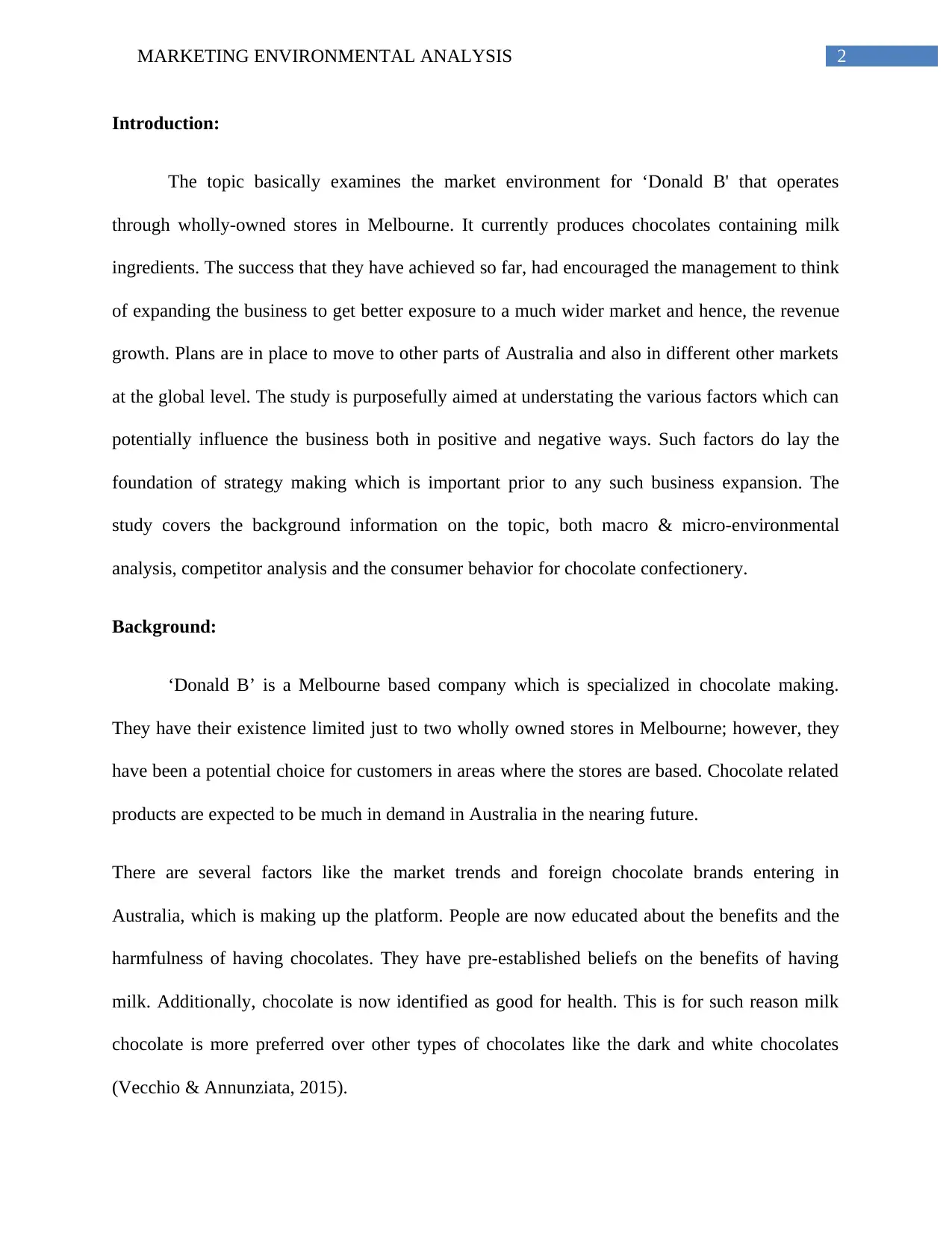
2MARKETING ENVIRONMENTAL ANALYSIS
Introduction:
The topic basically examines the market environment for ‘Donald B' that operates
through wholly-owned stores in Melbourne. It currently produces chocolates containing milk
ingredients. The success that they have achieved so far, had encouraged the management to think
of expanding the business to get better exposure to a much wider market and hence, the revenue
growth. Plans are in place to move to other parts of Australia and also in different other markets
at the global level. The study is purposefully aimed at understating the various factors which can
potentially influence the business both in positive and negative ways. Such factors do lay the
foundation of strategy making which is important prior to any such business expansion. The
study covers the background information on the topic, both macro & micro-environmental
analysis, competitor analysis and the consumer behavior for chocolate confectionery.
Background:
‘Donald B’ is a Melbourne based company which is specialized in chocolate making.
They have their existence limited just to two wholly owned stores in Melbourne; however, they
have been a potential choice for customers in areas where the stores are based. Chocolate related
products are expected to be much in demand in Australia in the nearing future.
There are several factors like the market trends and foreign chocolate brands entering in
Australia, which is making up the platform. People are now educated about the benefits and the
harmfulness of having chocolates. They have pre-established beliefs on the benefits of having
milk. Additionally, chocolate is now identified as good for health. This is for such reason milk
chocolate is more preferred over other types of chocolates like the dark and white chocolates
(Vecchio & Annunziata, 2015).
Introduction:
The topic basically examines the market environment for ‘Donald B' that operates
through wholly-owned stores in Melbourne. It currently produces chocolates containing milk
ingredients. The success that they have achieved so far, had encouraged the management to think
of expanding the business to get better exposure to a much wider market and hence, the revenue
growth. Plans are in place to move to other parts of Australia and also in different other markets
at the global level. The study is purposefully aimed at understating the various factors which can
potentially influence the business both in positive and negative ways. Such factors do lay the
foundation of strategy making which is important prior to any such business expansion. The
study covers the background information on the topic, both macro & micro-environmental
analysis, competitor analysis and the consumer behavior for chocolate confectionery.
Background:
‘Donald B’ is a Melbourne based company which is specialized in chocolate making.
They have their existence limited just to two wholly owned stores in Melbourne; however, they
have been a potential choice for customers in areas where the stores are based. Chocolate related
products are expected to be much in demand in Australia in the nearing future.
There are several factors like the market trends and foreign chocolate brands entering in
Australia, which is making up the platform. People are now educated about the benefits and the
harmfulness of having chocolates. They have pre-established beliefs on the benefits of having
milk. Additionally, chocolate is now identified as good for health. This is for such reason milk
chocolate is more preferred over other types of chocolates like the dark and white chocolates
(Vecchio & Annunziata, 2015).
⊘ This is a preview!⊘
Do you want full access?
Subscribe today to unlock all pages.

Trusted by 1+ million students worldwide
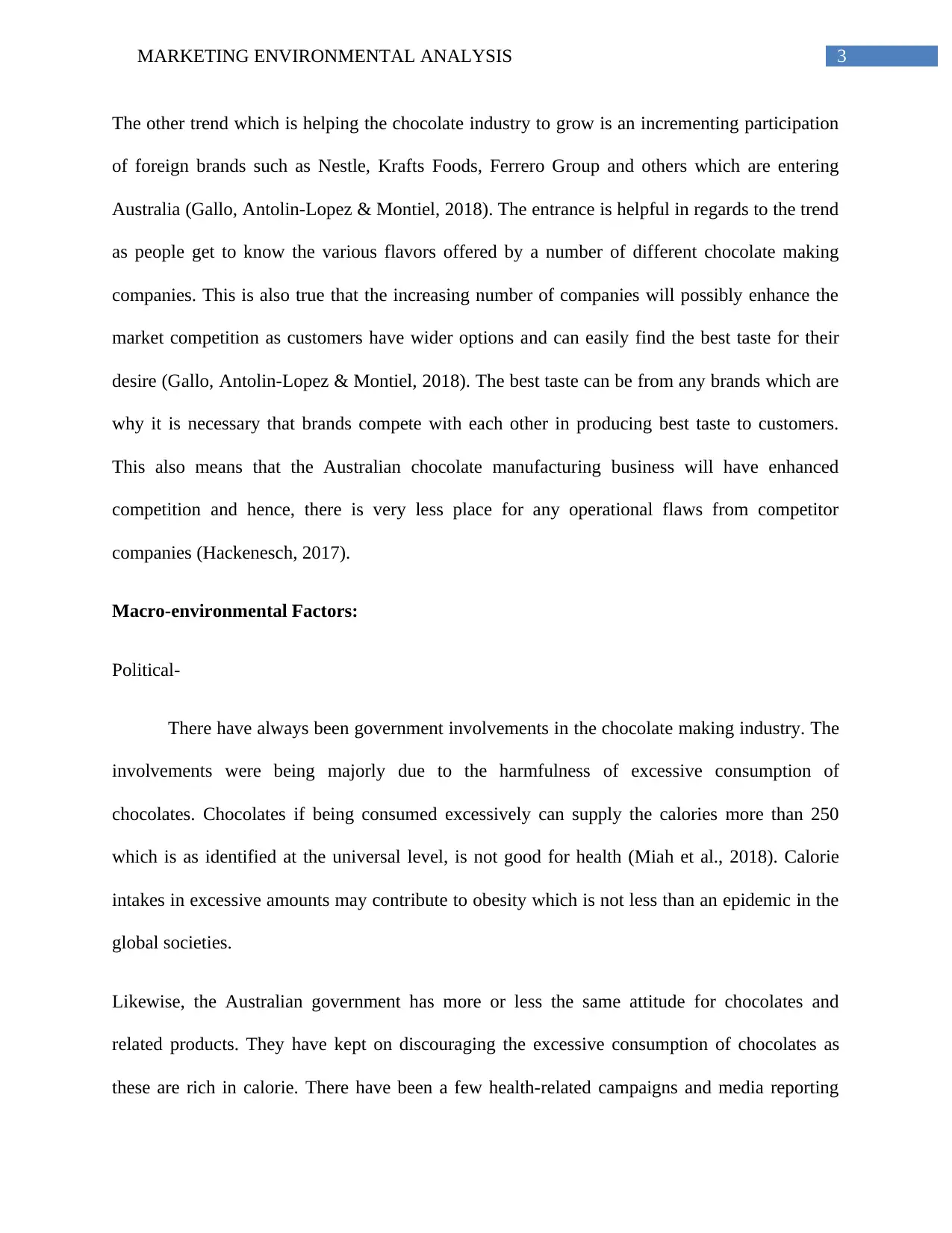
3MARKETING ENVIRONMENTAL ANALYSIS
The other trend which is helping the chocolate industry to grow is an incrementing participation
of foreign brands such as Nestle, Krafts Foods, Ferrero Group and others which are entering
Australia (Gallo, Antolin-Lopez & Montiel, 2018). The entrance is helpful in regards to the trend
as people get to know the various flavors offered by a number of different chocolate making
companies. This is also true that the increasing number of companies will possibly enhance the
market competition as customers have wider options and can easily find the best taste for their
desire (Gallo, Antolin-Lopez & Montiel, 2018). The best taste can be from any brands which are
why it is necessary that brands compete with each other in producing best taste to customers.
This also means that the Australian chocolate manufacturing business will have enhanced
competition and hence, there is very less place for any operational flaws from competitor
companies (Hackenesch, 2017).
Macro-environmental Factors:
Political-
There have always been government involvements in the chocolate making industry. The
involvements were being majorly due to the harmfulness of excessive consumption of
chocolates. Chocolates if being consumed excessively can supply the calories more than 250
which is as identified at the universal level, is not good for health (Miah et al., 2018). Calorie
intakes in excessive amounts may contribute to obesity which is not less than an epidemic in the
global societies.
Likewise, the Australian government has more or less the same attitude for chocolates and
related products. They have kept on discouraging the excessive consumption of chocolates as
these are rich in calorie. There have been a few health-related campaigns and media reporting
The other trend which is helping the chocolate industry to grow is an incrementing participation
of foreign brands such as Nestle, Krafts Foods, Ferrero Group and others which are entering
Australia (Gallo, Antolin-Lopez & Montiel, 2018). The entrance is helpful in regards to the trend
as people get to know the various flavors offered by a number of different chocolate making
companies. This is also true that the increasing number of companies will possibly enhance the
market competition as customers have wider options and can easily find the best taste for their
desire (Gallo, Antolin-Lopez & Montiel, 2018). The best taste can be from any brands which are
why it is necessary that brands compete with each other in producing best taste to customers.
This also means that the Australian chocolate manufacturing business will have enhanced
competition and hence, there is very less place for any operational flaws from competitor
companies (Hackenesch, 2017).
Macro-environmental Factors:
Political-
There have always been government involvements in the chocolate making industry. The
involvements were being majorly due to the harmfulness of excessive consumption of
chocolates. Chocolates if being consumed excessively can supply the calories more than 250
which is as identified at the universal level, is not good for health (Miah et al., 2018). Calorie
intakes in excessive amounts may contribute to obesity which is not less than an epidemic in the
global societies.
Likewise, the Australian government has more or less the same attitude for chocolates and
related products. They have kept on discouraging the excessive consumption of chocolates as
these are rich in calorie. There have been a few health-related campaigns and media reporting
Paraphrase This Document
Need a fresh take? Get an instant paraphrase of this document with our AI Paraphraser
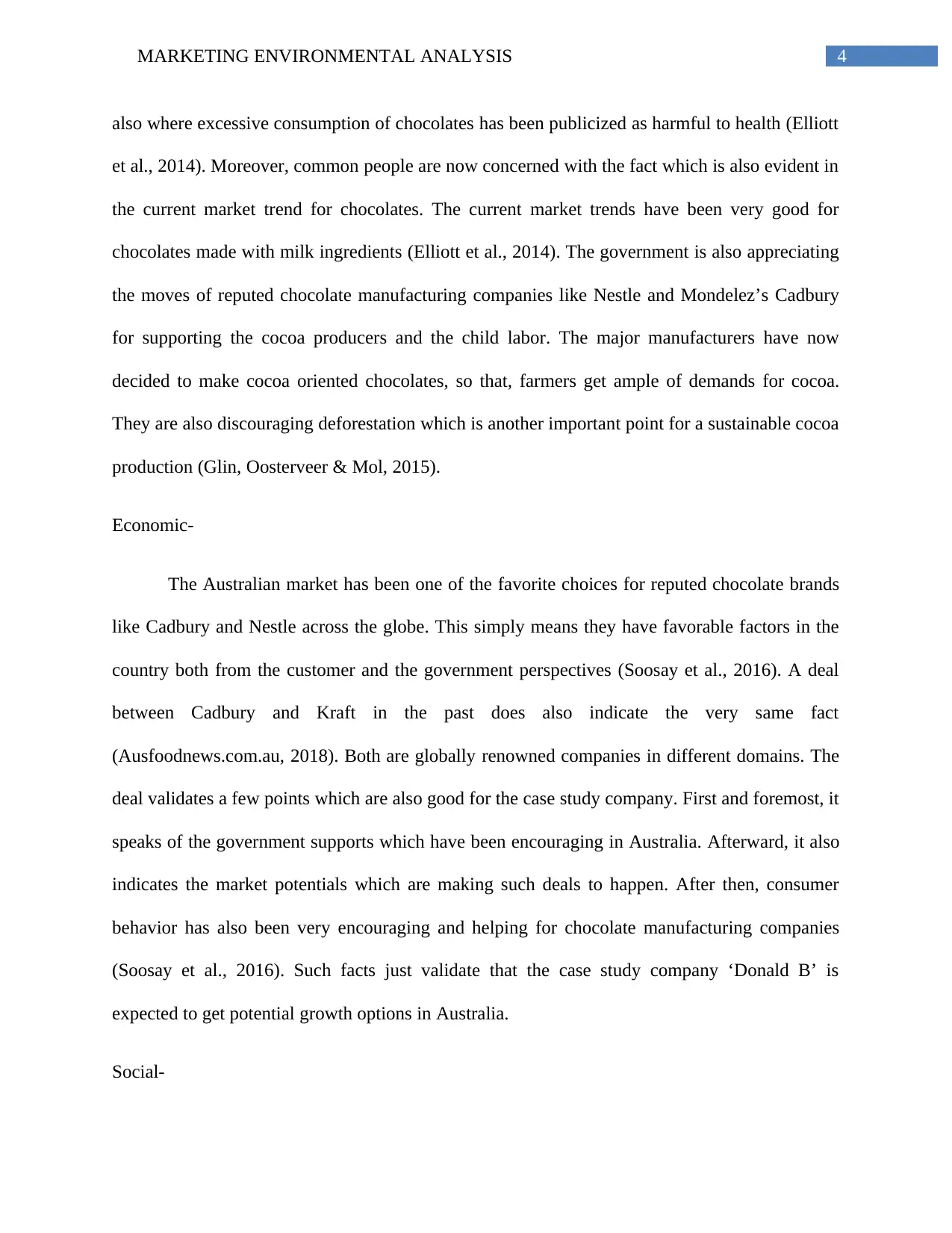
4MARKETING ENVIRONMENTAL ANALYSIS
also where excessive consumption of chocolates has been publicized as harmful to health (Elliott
et al., 2014). Moreover, common people are now concerned with the fact which is also evident in
the current market trend for chocolates. The current market trends have been very good for
chocolates made with milk ingredients (Elliott et al., 2014). The government is also appreciating
the moves of reputed chocolate manufacturing companies like Nestle and Mondelez’s Cadbury
for supporting the cocoa producers and the child labor. The major manufacturers have now
decided to make cocoa oriented chocolates, so that, farmers get ample of demands for cocoa.
They are also discouraging deforestation which is another important point for a sustainable cocoa
production (Glin, Oosterveer & Mol, 2015).
Economic-
The Australian market has been one of the favorite choices for reputed chocolate brands
like Cadbury and Nestle across the globe. This simply means they have favorable factors in the
country both from the customer and the government perspectives (Soosay et al., 2016). A deal
between Cadbury and Kraft in the past does also indicate the very same fact
(Ausfoodnews.com.au, 2018). Both are globally renowned companies in different domains. The
deal validates a few points which are also good for the case study company. First and foremost, it
speaks of the government supports which have been encouraging in Australia. Afterward, it also
indicates the market potentials which are making such deals to happen. After then, consumer
behavior has also been very encouraging and helping for chocolate manufacturing companies
(Soosay et al., 2016). Such facts just validate that the case study company ‘Donald B’ is
expected to get potential growth options in Australia.
Social-
also where excessive consumption of chocolates has been publicized as harmful to health (Elliott
et al., 2014). Moreover, common people are now concerned with the fact which is also evident in
the current market trend for chocolates. The current market trends have been very good for
chocolates made with milk ingredients (Elliott et al., 2014). The government is also appreciating
the moves of reputed chocolate manufacturing companies like Nestle and Mondelez’s Cadbury
for supporting the cocoa producers and the child labor. The major manufacturers have now
decided to make cocoa oriented chocolates, so that, farmers get ample of demands for cocoa.
They are also discouraging deforestation which is another important point for a sustainable cocoa
production (Glin, Oosterveer & Mol, 2015).
Economic-
The Australian market has been one of the favorite choices for reputed chocolate brands
like Cadbury and Nestle across the globe. This simply means they have favorable factors in the
country both from the customer and the government perspectives (Soosay et al., 2016). A deal
between Cadbury and Kraft in the past does also indicate the very same fact
(Ausfoodnews.com.au, 2018). Both are globally renowned companies in different domains. The
deal validates a few points which are also good for the case study company. First and foremost, it
speaks of the government supports which have been encouraging in Australia. Afterward, it also
indicates the market potentials which are making such deals to happen. After then, consumer
behavior has also been very encouraging and helping for chocolate manufacturing companies
(Soosay et al., 2016). Such facts just validate that the case study company ‘Donald B’ is
expected to get potential growth options in Australia.
Social-
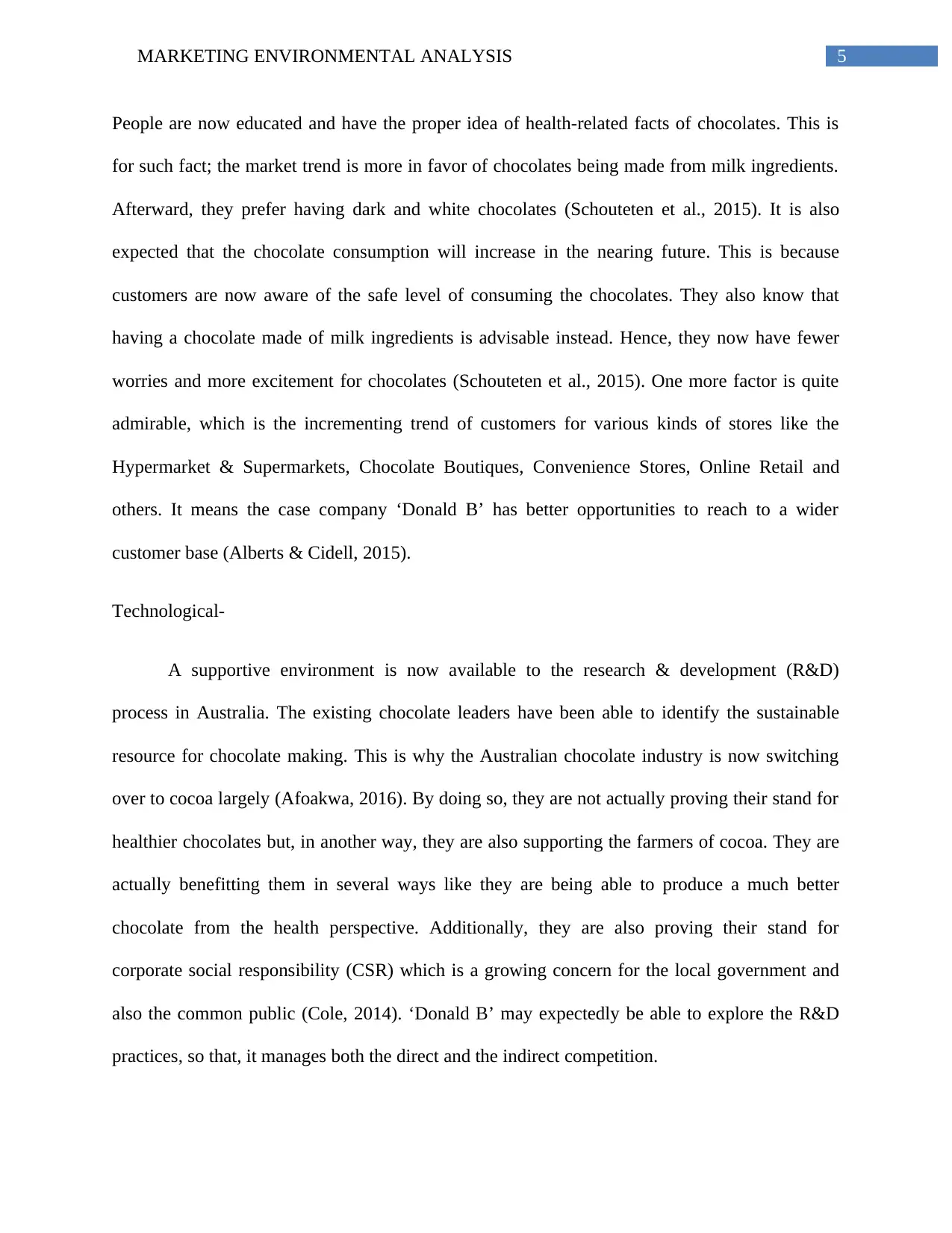
5MARKETING ENVIRONMENTAL ANALYSIS
People are now educated and have the proper idea of health-related facts of chocolates. This is
for such fact; the market trend is more in favor of chocolates being made from milk ingredients.
Afterward, they prefer having dark and white chocolates (Schouteten et al., 2015). It is also
expected that the chocolate consumption will increase in the nearing future. This is because
customers are now aware of the safe level of consuming the chocolates. They also know that
having a chocolate made of milk ingredients is advisable instead. Hence, they now have fewer
worries and more excitement for chocolates (Schouteten et al., 2015). One more factor is quite
admirable, which is the incrementing trend of customers for various kinds of stores like the
Hypermarket & Supermarkets, Chocolate Boutiques, Convenience Stores, Online Retail and
others. It means the case company ‘Donald B’ has better opportunities to reach to a wider
customer base (Alberts & Cidell, 2015).
Technological-
A supportive environment is now available to the research & development (R&D)
process in Australia. The existing chocolate leaders have been able to identify the sustainable
resource for chocolate making. This is why the Australian chocolate industry is now switching
over to cocoa largely (Afoakwa, 2016). By doing so, they are not actually proving their stand for
healthier chocolates but, in another way, they are also supporting the farmers of cocoa. They are
actually benefitting them in several ways like they are being able to produce a much better
chocolate from the health perspective. Additionally, they are also proving their stand for
corporate social responsibility (CSR) which is a growing concern for the local government and
also the common public (Cole, 2014). ‘Donald B’ may expectedly be able to explore the R&D
practices, so that, it manages both the direct and the indirect competition.
People are now educated and have the proper idea of health-related facts of chocolates. This is
for such fact; the market trend is more in favor of chocolates being made from milk ingredients.
Afterward, they prefer having dark and white chocolates (Schouteten et al., 2015). It is also
expected that the chocolate consumption will increase in the nearing future. This is because
customers are now aware of the safe level of consuming the chocolates. They also know that
having a chocolate made of milk ingredients is advisable instead. Hence, they now have fewer
worries and more excitement for chocolates (Schouteten et al., 2015). One more factor is quite
admirable, which is the incrementing trend of customers for various kinds of stores like the
Hypermarket & Supermarkets, Chocolate Boutiques, Convenience Stores, Online Retail and
others. It means the case company ‘Donald B’ has better opportunities to reach to a wider
customer base (Alberts & Cidell, 2015).
Technological-
A supportive environment is now available to the research & development (R&D)
process in Australia. The existing chocolate leaders have been able to identify the sustainable
resource for chocolate making. This is why the Australian chocolate industry is now switching
over to cocoa largely (Afoakwa, 2016). By doing so, they are not actually proving their stand for
healthier chocolates but, in another way, they are also supporting the farmers of cocoa. They are
actually benefitting them in several ways like they are being able to produce a much better
chocolate from the health perspective. Additionally, they are also proving their stand for
corporate social responsibility (CSR) which is a growing concern for the local government and
also the common public (Cole, 2014). ‘Donald B’ may expectedly be able to explore the R&D
practices, so that, it manages both the direct and the indirect competition.
⊘ This is a preview!⊘
Do you want full access?
Subscribe today to unlock all pages.

Trusted by 1+ million students worldwide
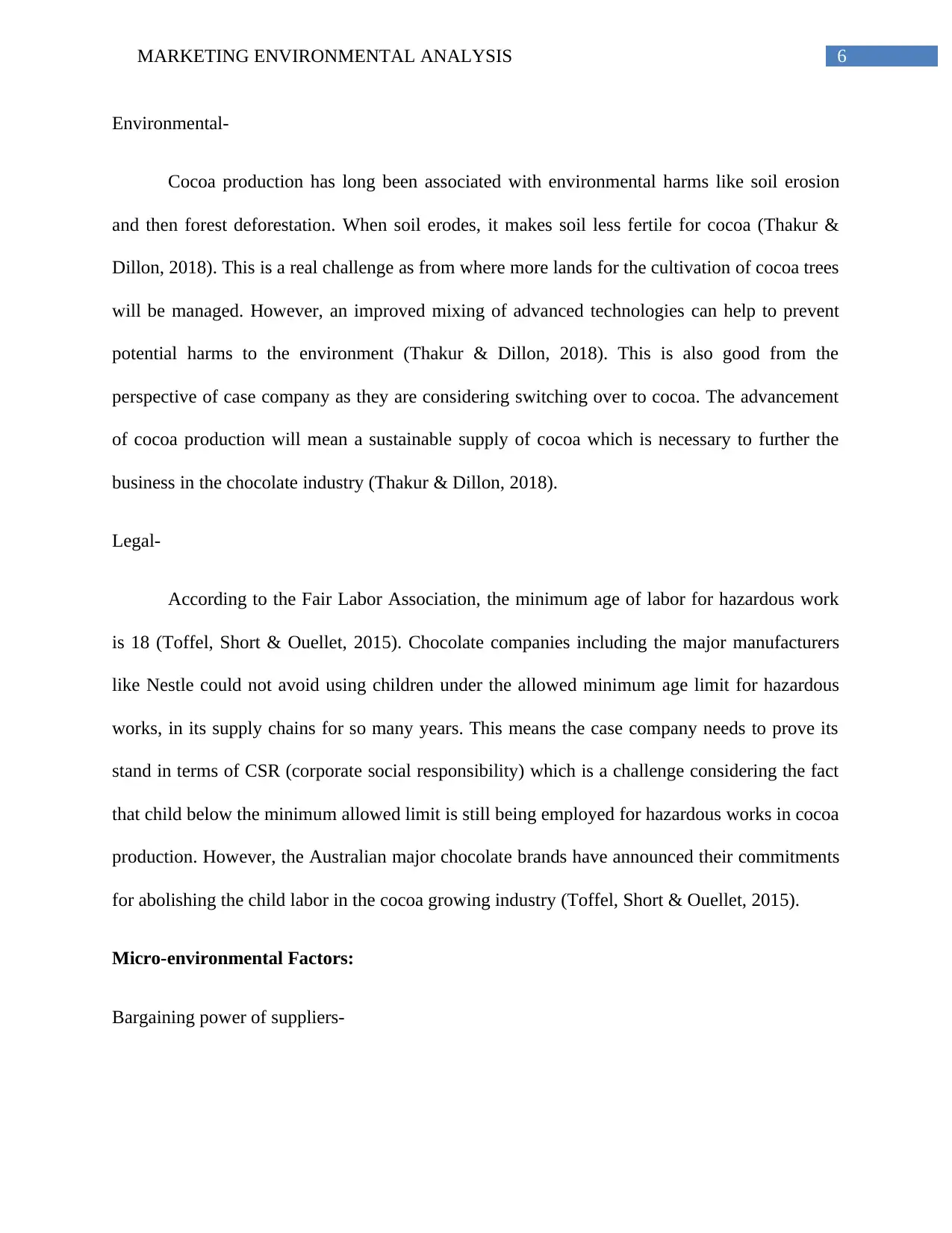
6MARKETING ENVIRONMENTAL ANALYSIS
Environmental-
Cocoa production has long been associated with environmental harms like soil erosion
and then forest deforestation. When soil erodes, it makes soil less fertile for cocoa (Thakur &
Dillon, 2018). This is a real challenge as from where more lands for the cultivation of cocoa trees
will be managed. However, an improved mixing of advanced technologies can help to prevent
potential harms to the environment (Thakur & Dillon, 2018). This is also good from the
perspective of case company as they are considering switching over to cocoa. The advancement
of cocoa production will mean a sustainable supply of cocoa which is necessary to further the
business in the chocolate industry (Thakur & Dillon, 2018).
Legal-
According to the Fair Labor Association, the minimum age of labor for hazardous work
is 18 (Toffel, Short & Ouellet, 2015). Chocolate companies including the major manufacturers
like Nestle could not avoid using children under the allowed minimum age limit for hazardous
works, in its supply chains for so many years. This means the case company needs to prove its
stand in terms of CSR (corporate social responsibility) which is a challenge considering the fact
that child below the minimum allowed limit is still being employed for hazardous works in cocoa
production. However, the Australian major chocolate brands have announced their commitments
for abolishing the child labor in the cocoa growing industry (Toffel, Short & Ouellet, 2015).
Micro-environmental Factors:
Bargaining power of suppliers-
Environmental-
Cocoa production has long been associated with environmental harms like soil erosion
and then forest deforestation. When soil erodes, it makes soil less fertile for cocoa (Thakur &
Dillon, 2018). This is a real challenge as from where more lands for the cultivation of cocoa trees
will be managed. However, an improved mixing of advanced technologies can help to prevent
potential harms to the environment (Thakur & Dillon, 2018). This is also good from the
perspective of case company as they are considering switching over to cocoa. The advancement
of cocoa production will mean a sustainable supply of cocoa which is necessary to further the
business in the chocolate industry (Thakur & Dillon, 2018).
Legal-
According to the Fair Labor Association, the minimum age of labor for hazardous work
is 18 (Toffel, Short & Ouellet, 2015). Chocolate companies including the major manufacturers
like Nestle could not avoid using children under the allowed minimum age limit for hazardous
works, in its supply chains for so many years. This means the case company needs to prove its
stand in terms of CSR (corporate social responsibility) which is a challenge considering the fact
that child below the minimum allowed limit is still being employed for hazardous works in cocoa
production. However, the Australian major chocolate brands have announced their commitments
for abolishing the child labor in the cocoa growing industry (Toffel, Short & Ouellet, 2015).
Micro-environmental Factors:
Bargaining power of suppliers-
Paraphrase This Document
Need a fresh take? Get an instant paraphrase of this document with our AI Paraphraser
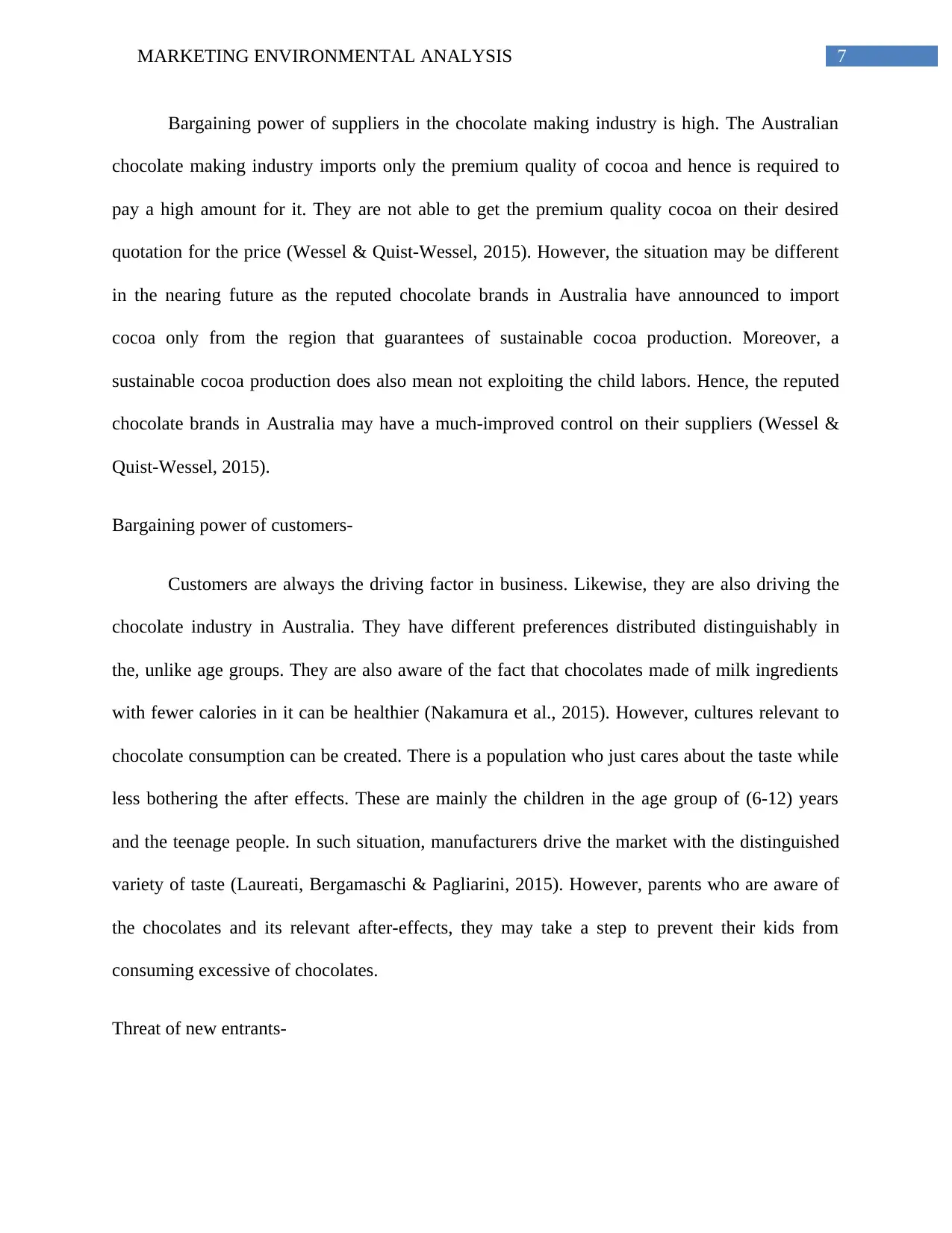
7MARKETING ENVIRONMENTAL ANALYSIS
Bargaining power of suppliers in the chocolate making industry is high. The Australian
chocolate making industry imports only the premium quality of cocoa and hence is required to
pay a high amount for it. They are not able to get the premium quality cocoa on their desired
quotation for the price (Wessel & Quist-Wessel, 2015). However, the situation may be different
in the nearing future as the reputed chocolate brands in Australia have announced to import
cocoa only from the region that guarantees of sustainable cocoa production. Moreover, a
sustainable cocoa production does also mean not exploiting the child labors. Hence, the reputed
chocolate brands in Australia may have a much-improved control on their suppliers (Wessel &
Quist-Wessel, 2015).
Bargaining power of customers-
Customers are always the driving factor in business. Likewise, they are also driving the
chocolate industry in Australia. They have different preferences distributed distinguishably in
the, unlike age groups. They are also aware of the fact that chocolates made of milk ingredients
with fewer calories in it can be healthier (Nakamura et al., 2015). However, cultures relevant to
chocolate consumption can be created. There is a population who just cares about the taste while
less bothering the after effects. These are mainly the children in the age group of (6-12) years
and the teenage people. In such situation, manufacturers drive the market with the distinguished
variety of taste (Laureati, Bergamaschi & Pagliarini, 2015). However, parents who are aware of
the chocolates and its relevant after-effects, they may take a step to prevent their kids from
consuming excessive of chocolates.
Threat of new entrants-
Bargaining power of suppliers in the chocolate making industry is high. The Australian
chocolate making industry imports only the premium quality of cocoa and hence is required to
pay a high amount for it. They are not able to get the premium quality cocoa on their desired
quotation for the price (Wessel & Quist-Wessel, 2015). However, the situation may be different
in the nearing future as the reputed chocolate brands in Australia have announced to import
cocoa only from the region that guarantees of sustainable cocoa production. Moreover, a
sustainable cocoa production does also mean not exploiting the child labors. Hence, the reputed
chocolate brands in Australia may have a much-improved control on their suppliers (Wessel &
Quist-Wessel, 2015).
Bargaining power of customers-
Customers are always the driving factor in business. Likewise, they are also driving the
chocolate industry in Australia. They have different preferences distributed distinguishably in
the, unlike age groups. They are also aware of the fact that chocolates made of milk ingredients
with fewer calories in it can be healthier (Nakamura et al., 2015). However, cultures relevant to
chocolate consumption can be created. There is a population who just cares about the taste while
less bothering the after effects. These are mainly the children in the age group of (6-12) years
and the teenage people. In such situation, manufacturers drive the market with the distinguished
variety of taste (Laureati, Bergamaschi & Pagliarini, 2015). However, parents who are aware of
the chocolates and its relevant after-effects, they may take a step to prevent their kids from
consuming excessive of chocolates.
Threat of new entrants-
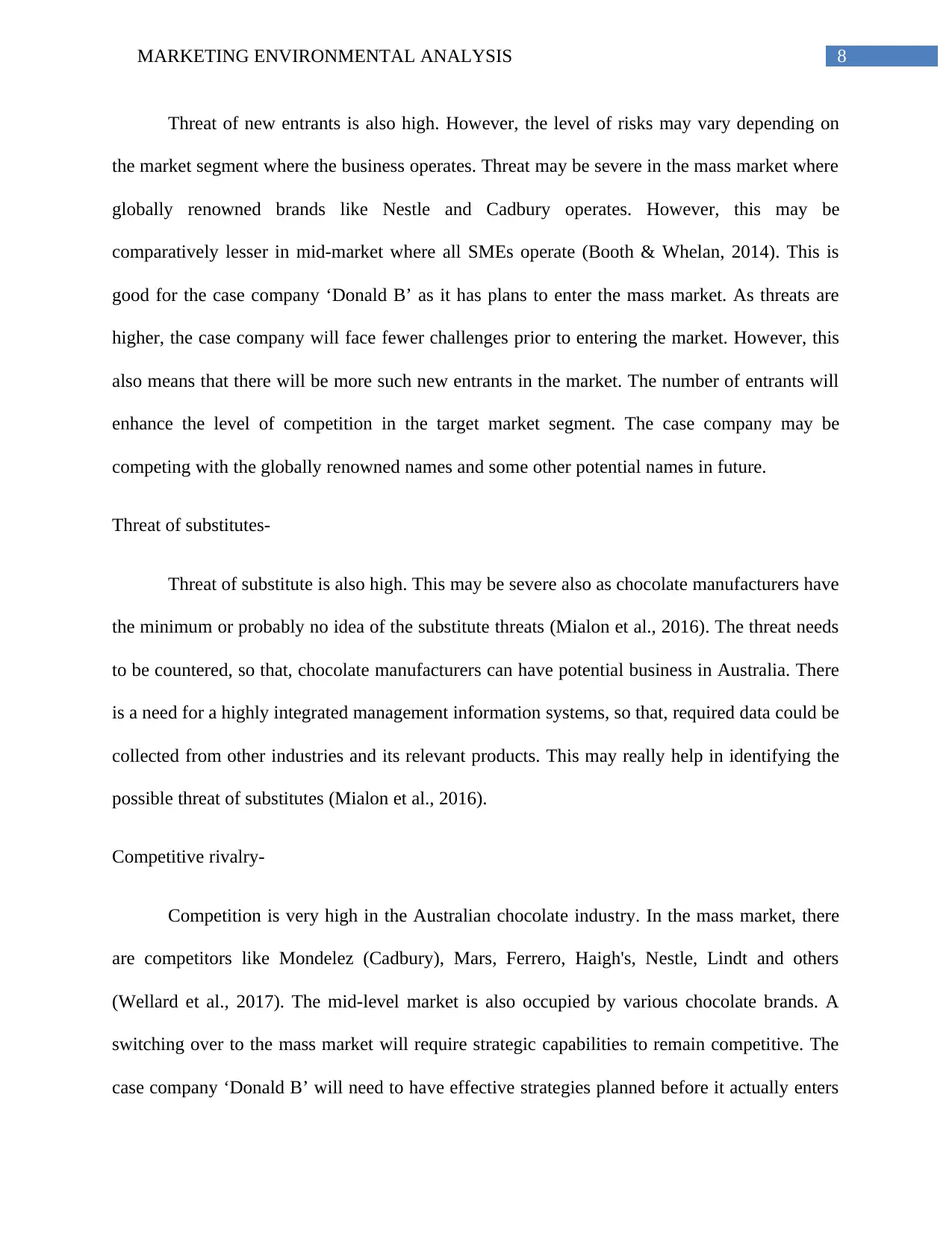
8MARKETING ENVIRONMENTAL ANALYSIS
Threat of new entrants is also high. However, the level of risks may vary depending on
the market segment where the business operates. Threat may be severe in the mass market where
globally renowned brands like Nestle and Cadbury operates. However, this may be
comparatively lesser in mid-market where all SMEs operate (Booth & Whelan, 2014). This is
good for the case company ‘Donald B’ as it has plans to enter the mass market. As threats are
higher, the case company will face fewer challenges prior to entering the market. However, this
also means that there will be more such new entrants in the market. The number of entrants will
enhance the level of competition in the target market segment. The case company may be
competing with the globally renowned names and some other potential names in future.
Threat of substitutes-
Threat of substitute is also high. This may be severe also as chocolate manufacturers have
the minimum or probably no idea of the substitute threats (Mialon et al., 2016). The threat needs
to be countered, so that, chocolate manufacturers can have potential business in Australia. There
is a need for a highly integrated management information systems, so that, required data could be
collected from other industries and its relevant products. This may really help in identifying the
possible threat of substitutes (Mialon et al., 2016).
Competitive rivalry-
Competition is very high in the Australian chocolate industry. In the mass market, there
are competitors like Mondelez (Cadbury), Mars, Ferrero, Haigh's, Nestle, Lindt and others
(Wellard et al., 2017). The mid-level market is also occupied by various chocolate brands. A
switching over to the mass market will require strategic capabilities to remain competitive. The
case company ‘Donald B’ will need to have effective strategies planned before it actually enters
Threat of new entrants is also high. However, the level of risks may vary depending on
the market segment where the business operates. Threat may be severe in the mass market where
globally renowned brands like Nestle and Cadbury operates. However, this may be
comparatively lesser in mid-market where all SMEs operate (Booth & Whelan, 2014). This is
good for the case company ‘Donald B’ as it has plans to enter the mass market. As threats are
higher, the case company will face fewer challenges prior to entering the market. However, this
also means that there will be more such new entrants in the market. The number of entrants will
enhance the level of competition in the target market segment. The case company may be
competing with the globally renowned names and some other potential names in future.
Threat of substitutes-
Threat of substitute is also high. This may be severe also as chocolate manufacturers have
the minimum or probably no idea of the substitute threats (Mialon et al., 2016). The threat needs
to be countered, so that, chocolate manufacturers can have potential business in Australia. There
is a need for a highly integrated management information systems, so that, required data could be
collected from other industries and its relevant products. This may really help in identifying the
possible threat of substitutes (Mialon et al., 2016).
Competitive rivalry-
Competition is very high in the Australian chocolate industry. In the mass market, there
are competitors like Mondelez (Cadbury), Mars, Ferrero, Haigh's, Nestle, Lindt and others
(Wellard et al., 2017). The mid-level market is also occupied by various chocolate brands. A
switching over to the mass market will require strategic capabilities to remain competitive. The
case company ‘Donald B’ will need to have effective strategies planned before it actually enters
⊘ This is a preview!⊘
Do you want full access?
Subscribe today to unlock all pages.

Trusted by 1+ million students worldwide
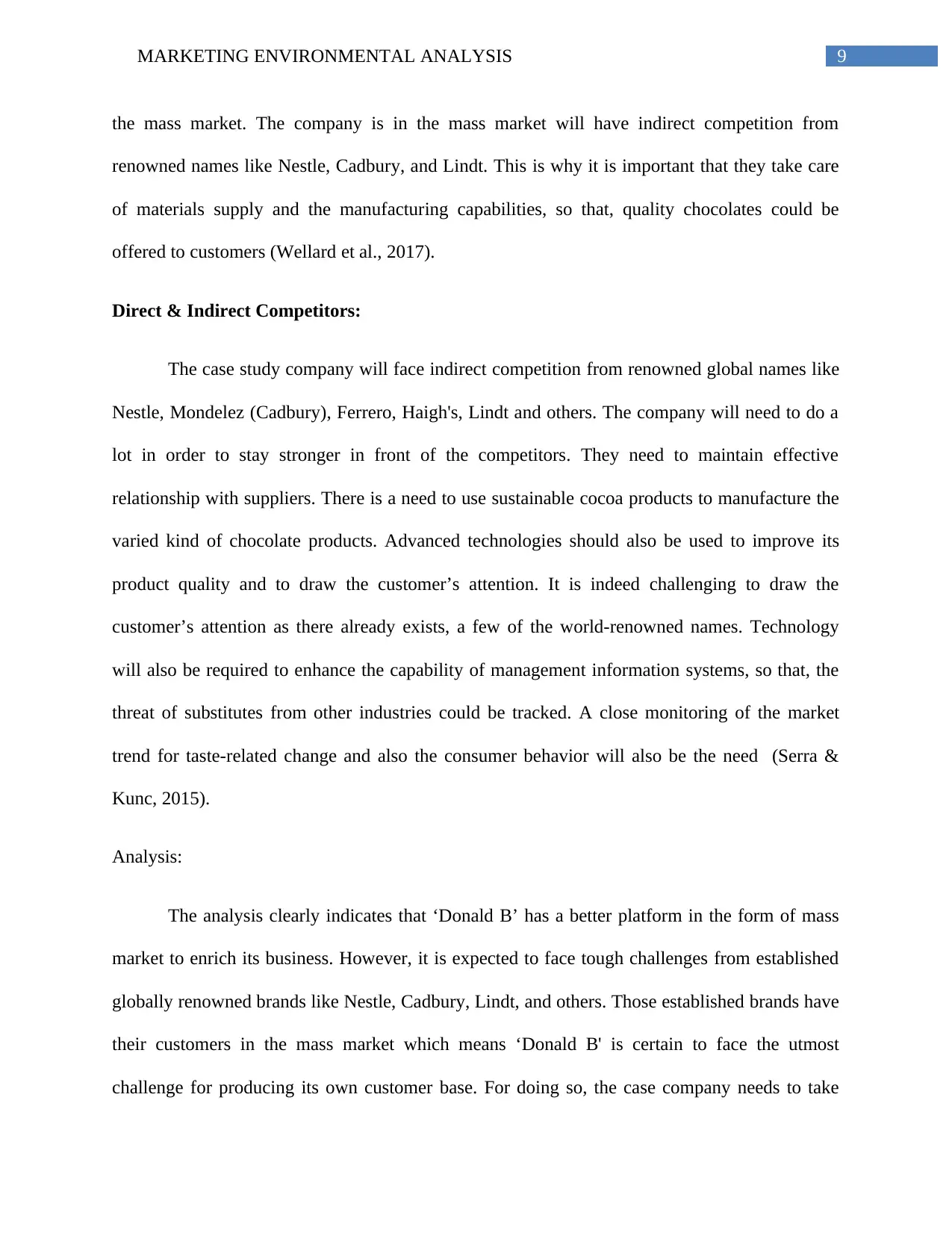
9MARKETING ENVIRONMENTAL ANALYSIS
the mass market. The company is in the mass market will have indirect competition from
renowned names like Nestle, Cadbury, and Lindt. This is why it is important that they take care
of materials supply and the manufacturing capabilities, so that, quality chocolates could be
offered to customers (Wellard et al., 2017).
Direct & Indirect Competitors:
The case study company will face indirect competition from renowned global names like
Nestle, Mondelez (Cadbury), Ferrero, Haigh's, Lindt and others. The company will need to do a
lot in order to stay stronger in front of the competitors. They need to maintain effective
relationship with suppliers. There is a need to use sustainable cocoa products to manufacture the
varied kind of chocolate products. Advanced technologies should also be used to improve its
product quality and to draw the customer’s attention. It is indeed challenging to draw the
customer’s attention as there already exists, a few of the world-renowned names. Technology
will also be required to enhance the capability of management information systems, so that, the
threat of substitutes from other industries could be tracked. A close monitoring of the market
trend for taste-related change and also the consumer behavior will also be the need (Serra &
Kunc, 2015).
Analysis:
The analysis clearly indicates that ‘Donald B’ has a better platform in the form of mass
market to enrich its business. However, it is expected to face tough challenges from established
globally renowned brands like Nestle, Cadbury, Lindt, and others. Those established brands have
their customers in the mass market which means ‘Donald B' is certain to face the utmost
challenge for producing its own customer base. For doing so, the case company needs to take
the mass market. The company is in the mass market will have indirect competition from
renowned names like Nestle, Cadbury, and Lindt. This is why it is important that they take care
of materials supply and the manufacturing capabilities, so that, quality chocolates could be
offered to customers (Wellard et al., 2017).
Direct & Indirect Competitors:
The case study company will face indirect competition from renowned global names like
Nestle, Mondelez (Cadbury), Ferrero, Haigh's, Lindt and others. The company will need to do a
lot in order to stay stronger in front of the competitors. They need to maintain effective
relationship with suppliers. There is a need to use sustainable cocoa products to manufacture the
varied kind of chocolate products. Advanced technologies should also be used to improve its
product quality and to draw the customer’s attention. It is indeed challenging to draw the
customer’s attention as there already exists, a few of the world-renowned names. Technology
will also be required to enhance the capability of management information systems, so that, the
threat of substitutes from other industries could be tracked. A close monitoring of the market
trend for taste-related change and also the consumer behavior will also be the need (Serra &
Kunc, 2015).
Analysis:
The analysis clearly indicates that ‘Donald B’ has a better platform in the form of mass
market to enrich its business. However, it is expected to face tough challenges from established
globally renowned brands like Nestle, Cadbury, Lindt, and others. Those established brands have
their customers in the mass market which means ‘Donald B' is certain to face the utmost
challenge for producing its own customer base. For doing so, the case company needs to take
Paraphrase This Document
Need a fresh take? Get an instant paraphrase of this document with our AI Paraphraser
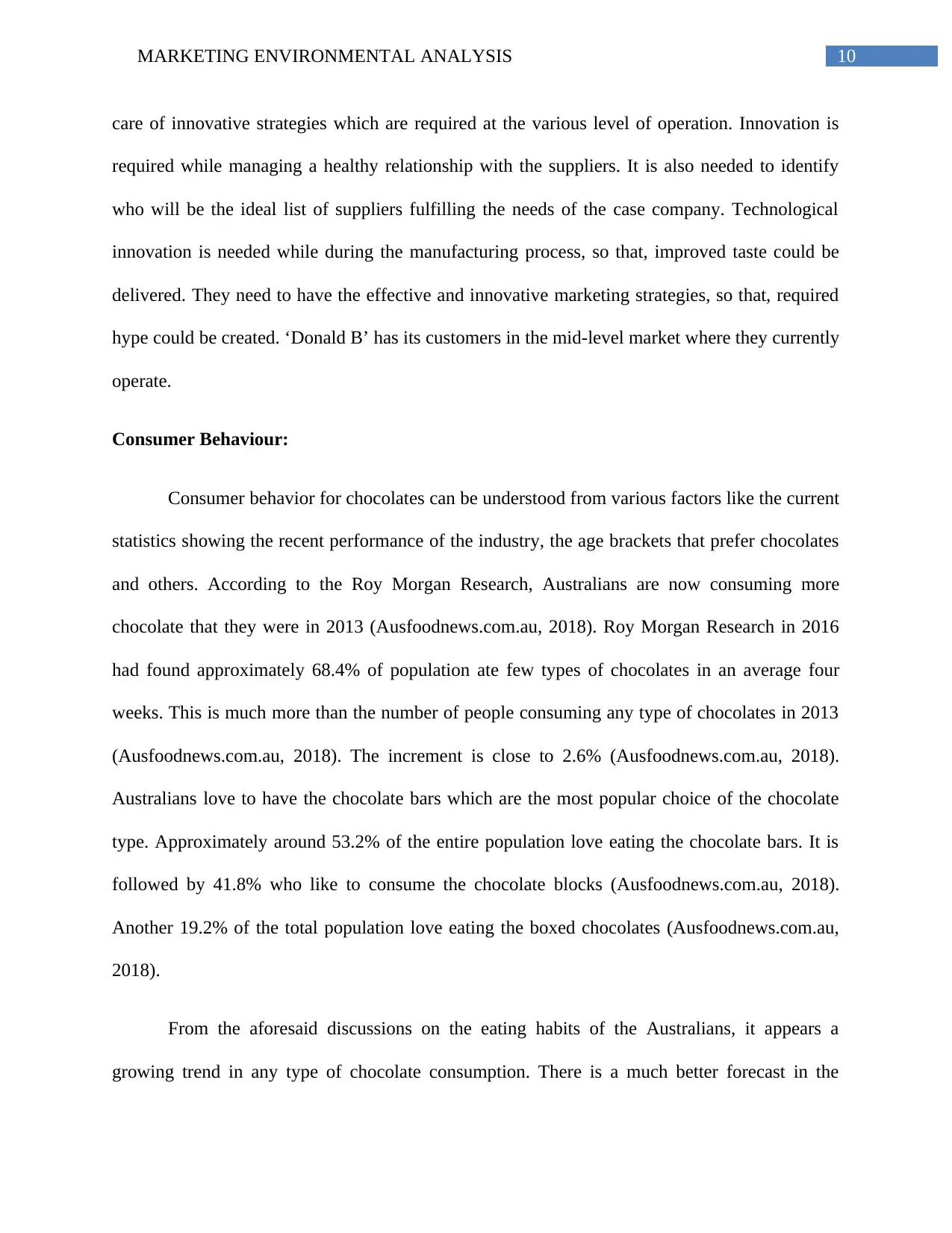
10MARKETING ENVIRONMENTAL ANALYSIS
care of innovative strategies which are required at the various level of operation. Innovation is
required while managing a healthy relationship with the suppliers. It is also needed to identify
who will be the ideal list of suppliers fulfilling the needs of the case company. Technological
innovation is needed while during the manufacturing process, so that, improved taste could be
delivered. They need to have the effective and innovative marketing strategies, so that, required
hype could be created. ‘Donald B’ has its customers in the mid-level market where they currently
operate.
Consumer Behaviour:
Consumer behavior for chocolates can be understood from various factors like the current
statistics showing the recent performance of the industry, the age brackets that prefer chocolates
and others. According to the Roy Morgan Research, Australians are now consuming more
chocolate that they were in 2013 (Ausfoodnews.com.au, 2018). Roy Morgan Research in 2016
had found approximately 68.4% of population ate few types of chocolates in an average four
weeks. This is much more than the number of people consuming any type of chocolates in 2013
(Ausfoodnews.com.au, 2018). The increment is close to 2.6% (Ausfoodnews.com.au, 2018).
Australians love to have the chocolate bars which are the most popular choice of the chocolate
type. Approximately around 53.2% of the entire population love eating the chocolate bars. It is
followed by 41.8% who like to consume the chocolate blocks (Ausfoodnews.com.au, 2018).
Another 19.2% of the total population love eating the boxed chocolates (Ausfoodnews.com.au,
2018).
From the aforesaid discussions on the eating habits of the Australians, it appears a
growing trend in any type of chocolate consumption. There is a much better forecast in the
care of innovative strategies which are required at the various level of operation. Innovation is
required while managing a healthy relationship with the suppliers. It is also needed to identify
who will be the ideal list of suppliers fulfilling the needs of the case company. Technological
innovation is needed while during the manufacturing process, so that, improved taste could be
delivered. They need to have the effective and innovative marketing strategies, so that, required
hype could be created. ‘Donald B’ has its customers in the mid-level market where they currently
operate.
Consumer Behaviour:
Consumer behavior for chocolates can be understood from various factors like the current
statistics showing the recent performance of the industry, the age brackets that prefer chocolates
and others. According to the Roy Morgan Research, Australians are now consuming more
chocolate that they were in 2013 (Ausfoodnews.com.au, 2018). Roy Morgan Research in 2016
had found approximately 68.4% of population ate few types of chocolates in an average four
weeks. This is much more than the number of people consuming any type of chocolates in 2013
(Ausfoodnews.com.au, 2018). The increment is close to 2.6% (Ausfoodnews.com.au, 2018).
Australians love to have the chocolate bars which are the most popular choice of the chocolate
type. Approximately around 53.2% of the entire population love eating the chocolate bars. It is
followed by 41.8% who like to consume the chocolate blocks (Ausfoodnews.com.au, 2018).
Another 19.2% of the total population love eating the boxed chocolates (Ausfoodnews.com.au,
2018).
From the aforesaid discussions on the eating habits of the Australians, it appears a
growing trend in any type of chocolate consumption. There is a much better forecast in the
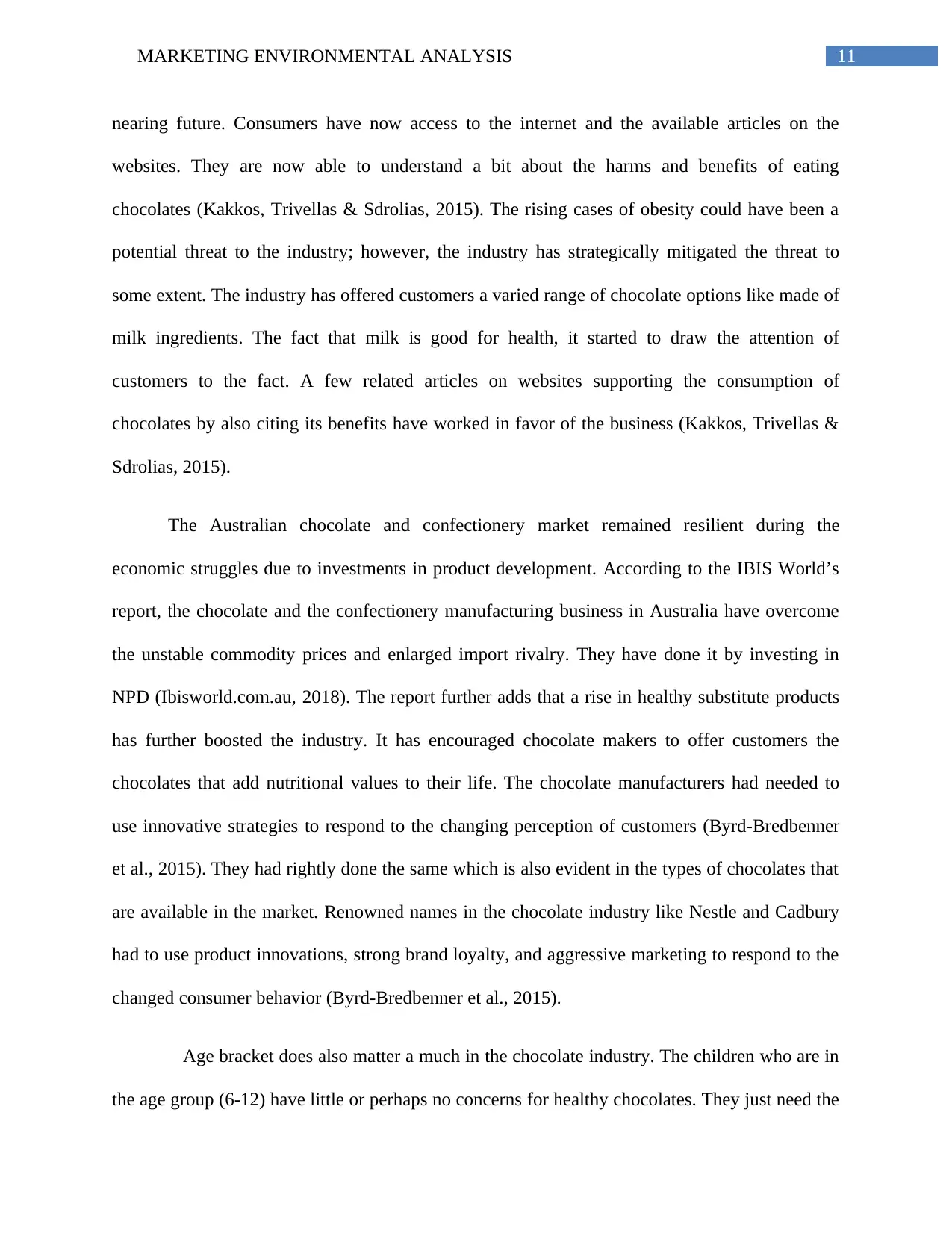
11MARKETING ENVIRONMENTAL ANALYSIS
nearing future. Consumers have now access to the internet and the available articles on the
websites. They are now able to understand a bit about the harms and benefits of eating
chocolates (Kakkos, Trivellas & Sdrolias, 2015). The rising cases of obesity could have been a
potential threat to the industry; however, the industry has strategically mitigated the threat to
some extent. The industry has offered customers a varied range of chocolate options like made of
milk ingredients. The fact that milk is good for health, it started to draw the attention of
customers to the fact. A few related articles on websites supporting the consumption of
chocolates by also citing its benefits have worked in favor of the business (Kakkos, Trivellas &
Sdrolias, 2015).
The Australian chocolate and confectionery market remained resilient during the
economic struggles due to investments in product development. According to the IBIS World’s
report, the chocolate and the confectionery manufacturing business in Australia have overcome
the unstable commodity prices and enlarged import rivalry. They have done it by investing in
NPD (Ibisworld.com.au, 2018). The report further adds that a rise in healthy substitute products
has further boosted the industry. It has encouraged chocolate makers to offer customers the
chocolates that add nutritional values to their life. The chocolate manufacturers had needed to
use innovative strategies to respond to the changing perception of customers (Byrd‐Bredbenner
et al., 2015). They had rightly done the same which is also evident in the types of chocolates that
are available in the market. Renowned names in the chocolate industry like Nestle and Cadbury
had to use product innovations, strong brand loyalty, and aggressive marketing to respond to the
changed consumer behavior (Byrd‐Bredbenner et al., 2015).
Age bracket does also matter a much in the chocolate industry. The children who are in
the age group (6-12) have little or perhaps no concerns for healthy chocolates. They just need the
nearing future. Consumers have now access to the internet and the available articles on the
websites. They are now able to understand a bit about the harms and benefits of eating
chocolates (Kakkos, Trivellas & Sdrolias, 2015). The rising cases of obesity could have been a
potential threat to the industry; however, the industry has strategically mitigated the threat to
some extent. The industry has offered customers a varied range of chocolate options like made of
milk ingredients. The fact that milk is good for health, it started to draw the attention of
customers to the fact. A few related articles on websites supporting the consumption of
chocolates by also citing its benefits have worked in favor of the business (Kakkos, Trivellas &
Sdrolias, 2015).
The Australian chocolate and confectionery market remained resilient during the
economic struggles due to investments in product development. According to the IBIS World’s
report, the chocolate and the confectionery manufacturing business in Australia have overcome
the unstable commodity prices and enlarged import rivalry. They have done it by investing in
NPD (Ibisworld.com.au, 2018). The report further adds that a rise in healthy substitute products
has further boosted the industry. It has encouraged chocolate makers to offer customers the
chocolates that add nutritional values to their life. The chocolate manufacturers had needed to
use innovative strategies to respond to the changing perception of customers (Byrd‐Bredbenner
et al., 2015). They had rightly done the same which is also evident in the types of chocolates that
are available in the market. Renowned names in the chocolate industry like Nestle and Cadbury
had to use product innovations, strong brand loyalty, and aggressive marketing to respond to the
changed consumer behavior (Byrd‐Bredbenner et al., 2015).
Age bracket does also matter a much in the chocolate industry. The children who are in
the age group (6-12) have little or perhaps no concerns for healthy chocolates. They just need the
⊘ This is a preview!⊘
Do you want full access?
Subscribe today to unlock all pages.

Trusted by 1+ million students worldwide
1 out of 18
Related Documents
Your All-in-One AI-Powered Toolkit for Academic Success.
+13062052269
info@desklib.com
Available 24*7 on WhatsApp / Email
![[object Object]](/_next/static/media/star-bottom.7253800d.svg)
Unlock your academic potential
Copyright © 2020–2025 A2Z Services. All Rights Reserved. Developed and managed by ZUCOL.




